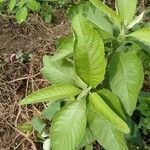Shrubs or subshrubs, perennial, erect, 1-3 m tall. Stems corymbosely branched, woody at base; bark grayish brown; branches terete, densely lanate-villous with yellowish white hairs. Leaves narrowly oblong, 15-18 × 3.5-5 cm, abaxially densely silky-lanate, adaxially rugose and pilose with blunt multicellular hairs, base narrowed, auriculate, auricles 10-12 mm on short petiole, margin serrulate to serrate usually with upcurved teeth, apex acuminate; veins 10-12 pairs. Capitula 6-7 mm, in spreading pyramidal panicles, pedunculate. Involucres campanulate; phyllaries in 3 or 4 series, densely lanate on outer surface, outer ones smaller, oblong-lanceolate 1-3 mm, compressed, inner longer, linear 5-6 mm. Receptacle 2.5-3 mm in diam., flat, alveolate, glabrous. Marginal florets filiform, to 6 mm, 2-4-lobed. Central florets yellow, tubular, 6-7 mm, lobes papillate, with sessile glands and sparse multicellular hairs. Achenes brown, terete, oblong, ca. 1 mm, sparsely hirsute. Pappus reddish, 4-6 mm. Fl. year-round. 2n = 18.
More
A small herb. It grows to 3 m tall. It is short lived. The bark is yellow-brown. The branches and leaves have a silky covering. The leaves are about 7-25 cm long by 3-10 cm wide. The flowers are in small heads. The flowers are yellow. The fruit are ribbed.
Dry fields, thickets, grasslands, mountain slopes, river banks at elevations up to 1,200 metres. Roadsides, upland fields, fields infested with Imperata, grazing land, brushwood and forest, and sometimes in wet places on river banks.
More
A tropical plant. It grows in forest. It can also grow in desert soils. It can grow in arid places. At MARDI. In XTBG Yunnan.




